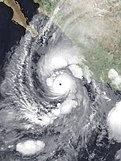The 2018 Pacific hurricane season was an event in the annual cycle of tropical cyclone formation, in which tropical cyclones form in the eastern Pacific Ocean. The 2018 season officially started on May 15 in the eastern Pacific – east of 140°W – and began on June 1 in the central Pacific – the region between the International Date Line and 140°W, and ended on November 30. The season began with the formation of Tropical Depression One-E, which developed on May 10, and ended with the dissipation of the season's final storm, Tropical Storm Xavier, which dissipated as a tropical cyclone on November 5. The 2018 hurricane season was exceptionally active and featured the highest accumulated cyclone energy (ACE) since reliable records began in 1971. Throughout the season, 26 tropical depressions developed, 23 of which became tropical storms. A total of 13 tropical storms reached hurricane strength, and 10 hurricanes achieved major hurricane intensity. Activity peaked from early August to early October, with several long-lived and powerful hurricanes developing in that time period. Several storms severely affected land, such as Hurricane Lane in Hawaii and Hurricane Willa (pictured) in Mexico. (Full list...)
